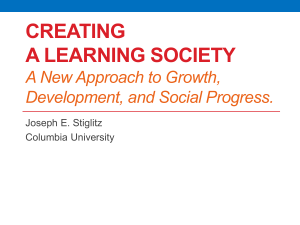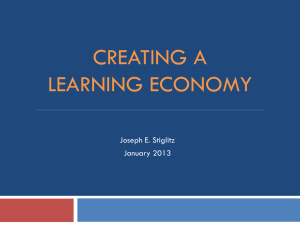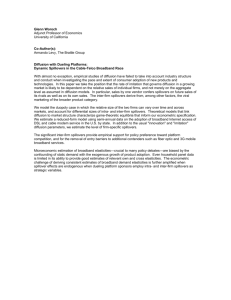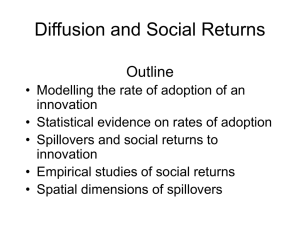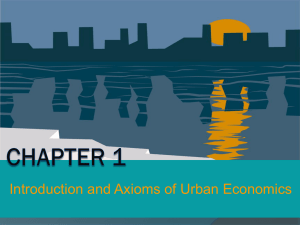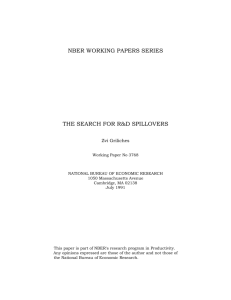Creating a Learning Society A New Approach to Growth
advertisement
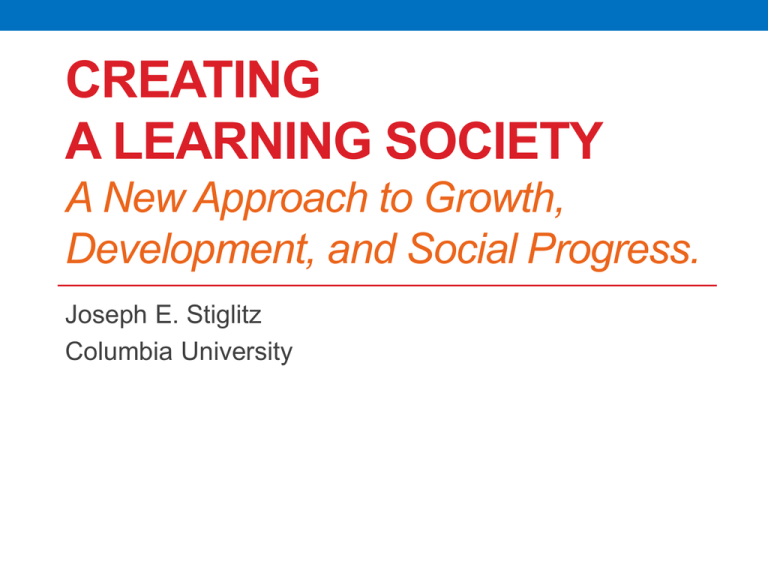
CREATING A LEARNING SOCIETY A New Approach to Growth, Development, and Social Progress. Joseph E. Stiglitz Columbia University Two themes • Successful and sustained growth requires creating a learning society. −Especially in the 21st century, as we move to a knowledge economy. • Markets on their own will not do this • There needs to be systematic interventions by the government On the importance of Creating a Learning Society • The transformation to “learning societies” that occurred around 1800 for Western economies, and more recently for those in Asia, appears to have had a far, far greater impact on human well-being than improvements in allocative efficiency or resource accumulation. • For hundreds of years standards of living had remained essentially unchanged • Since Solow, we have recognized that the most important determinant of growth is technological change − Recognized earlier by Schumpeter, but Solow gave us first quantification − Our focus should be on the impact of policies on technological change, learning Gaps in knowledge −In case of developing countries, focus on diffusion of knowledge −From developed to developing country −What separates developing from developed countries is as much a gap in knowledge as a gap in resources • But even in developed countries, large gaps between productivity of best and other firms • Undermines concept of an aggregate production function Market failure • Markets, on their own, are not efficient in promoting innovation. • Since Arrow, recognized that markets by themselves do not yield efficiency in the production and dissemination of knowledge − Knowledge as a public good − Spillovers/externalities − Other imperfections (capital markets, imperfect competition) inherently associated with innovation −Changed presumption from Smith’s invisible hand −Production of knowledge/learning different from production of conventional commodities −Results consistent with Greenwald-Stiglitz theorem − Whenever information is imperfect/asymmetric, risk markets imperfect markets are not (constrained Pareto) efficient − Information is similar to knowledge, so result not surprise Government policy • The policies that promote a transformation to a learning society are markedly different than those traditionally advocated by economists, which focus on improving the static efficiency of resource allocation and the accumulation of capital. • Including policies that constituted the Washington Consensus. • Indeed, from the perspective of creating a learning society, those policies may be counterproductive. Long recognized conflict between static and dynamic perspectives −Intellectual property restricts use of knowledge (a distortion— knowledge is a public good), and can even contribute to monopoly. −Willing to accept because dynamic benefits outweigh static costs − May be negative dynamic benefits (US) −Important to have a “developmentally oriented” intellectual property regime − With poorly designed IP regime, dynamic benefits less than the costs − TRIPS (regime of WTO) is NOT developmentally oriented − But important for countries to make full use of latitude given by TRIPS Implies that a central question of growth and development should be: • What should governments do to promote growth through learning (technological progress)? −Question is especially salient because such policies may be in conflict with conventionally advocated policies • Book looks comprehensively at factors affecting learning • Education system • The economy’s innovation system, including IPR and technology policy • Macro-economic policies, including exchange rate policy • Industrial and trade policies • Investment policies Multiple dimensions • How they affect capabilities of learning • How they affect incentives to learn (motivate learning) • How they facilitate learning and catalyze it • Including mindsets that are conducive to learning • Importance of the Enlightenment • How they impose impediments to learning • How does learning occur • Especial attention to learning by doing • Learning to learn • This lecture will focus on role of education system and trade and industrial policies Putting this into context • How to promote sustainable, equitable development? • More than just transfer of resources, developmental “projects” • Institutions and policies • But to what end? • Argument: policies and institutions that promote learning, closing the knowledge gap and promote broader conditions for learning should be central • Book identifies policies and institutions • Has less to say about how to create those institutions (issues of governance) • Argues that macro-stability and policies that promote equitable growth enhance learning • Providing further rationale for these policies • Based on Creating a Learning Society: A New Approach to Growth, Development, and Social Progress with Bruce Greenwald (Columbia University Press, 2014) I. Education • Needs to focus on “learning to learn”—life long learning • Only small part of learning occurs in “formal” schooling • Have to understand role of formal schooling vs. “life long learning” • Relationship changing with increasing pace of innovation, changes in labor market • Relationship changing with ability to access “knowledge” on internet • Need to know how to access, evaluate, and analyze knowledge base which is readily available • Changes in technology are allowing changes in learning Changes in education on the job • Less provision of education by employers • With greater labor mobility • Greater uncertainty about nature of future jobs • Implying greater need for individuals to have access to relevant continuing education Learning perspective has changed thinking about education in developing countries • Importance not just of primary education but secondary and tertiary • Learning skills that enable individuals to learn in the contexts in which they live • With many continuing to live in rural sector, a rural-based education—not just qualifying individuals for urban jobs Among central messages of WDR Knowledge for Development II. New perspectives on trade • Standard theories −Focus on comparative advantage −One-time gain from liberalization, opening up markets • Technology-based learning theories −Focus on diffusion of technology from developed to less developed countries −And spillovers from one sector to other −And learning within any sector • Within all countries, there are large differences between average and best practices − Suggesting large scope for “learning” − Localized learning—localized to technologies − Similar technologies can be used across sectors Dynamic comparative advantage— comparative advantage is endogenous −With learning by doing affected by what a country produces • Central then is understanding the structure of learning within an economy—including within and across sectors −Many processes, practices, and institutions entail crosssector learning/increases in productivity − Inventory control processes − Labor management processes − Computerization − Financial services Infant industry argument • Infant industries—economies of scale −Losses during “learning phase” serve as entry barriers, putting developing countries at disadvantage • In fact, learning by doing itself provides little basis of industrial policy −Consider a two-country, two-product Ricardian world with Cobb- Douglas utility functions, with one product with learning and the other stagnant (learning internalized in country) −Consider equilibrium in which “developed” country specializes in dynamic sector −With competition, full benefits of learning are shared with developing country through price declines Infant economy argument for protection • The industrial sector (broadly understood, including modern services) may not only exhibit a larger learning elasticity, but also more spillovers to the rural/agricultural sector • Markets fail to take into account of these externalities on their own • Korea provides an example of effective use of such policies Other market failures endemic to “learning” • Two cases: • Learning external to the firm • Failure to take into account learning benefits to industry as well as spillovers • Learning limited to the firm • Natural monopoly • If there were no cross-sectoral spillovers, rational firm would take into account all learning benefits • But distortion from monopoly power • In both cases, in general, market equilibrium not efficient • Markets do not design economic structure to maximize learning (or even to “optimize” trade-offs) • Schumpeter was wrong • Book explains crucial flaws in his analysis *Advantages of industrial sector • Large—high returns to scale • Long-lived—high returns from continuity (learning to learn) • Stable—high returns from completion • Concentrated—high rates of diffusion *Strong industrial sector is basis for: • More research– − More resources and incentives for research and development − More internalization − Greater ability to support public research and development − More human capital formation, including public support for human capital accumulation • The development of a robust financial sector • Learning to learn and cross-border knowledge flows Implication: Rate of productivity increase related to (relative) size of industrial sector. Policies • Optimal to impose some subsidies, even if taxes to finance subsidies are distortionary • Optimal subsidies lead to expansion of those sectors that have larger societal learning benefits, taking into account both direct learning and cross sectoral spillovers. −If the learning elasticity of some sector is much larger than that of others, and there is some sector that is a substitute for the highlearning sector, then it may pay to tax that sector, in order to encourage learning in the high-learning sector −Book provides precise formulae (analogous to Ramsey formulae) for optimal subsidies and taxes Trade protection is an alternative • Especially relevant where government cannot raise revenues through taxation to finance subsidies • Quotas, tariffs can encourage industrial sector Industrial policy in the presence of WTO constraints • Exchange rate policy may be an effective alternative −Lowering exchange rate below “equilibrium” (trade balance) leads to larger industrial sector and faster learning and trade surplus −Avoids the problem of “picking winners” −Avoids the problems posed by WTO restrictions • Even pays to have a perpetual current account surplus −Surprising — “capital” that one never uses −But learning benefit exceeds the opportunity cost of funds • But even if it were not desirable to do it forever, it may be an important element of development strategy −Problem with using steady-state models Extensions • Trade policy can affect factor prices, and therefore the level of investment, and therefore the level of learning −More than offsetting the social costs of distortion Learning to learn • We have focused on “learning,” but even more important is “learning to learn” −Industrial and trade policy can enhance an economy’s learning capacities • Introduces complex strategic questions Political economy objection • Ideal government intervention might improve matters −But real world interventions do not • Political economy objections may be true—but conclusion based on political analysis, not economic analysis −Political analysis often more simplistic than economic analysis −Moreover, liberalization is also a political agenda − Not “perfectly applied” − Asymmetric application can have adverse welfare effects Political economy objections −Critique of infant economy argument in particular −Government can’t pick winners −Infants never grow up −Better ways of providing assistance than protection—direct and transparent subsidies • Replies to critiques • Almost every successful country has had “industrial policies” • US from 19th century (telecommunications, agriculture) • Today mostly through Defense Department • Including Internet and biotech • With private sector playing central role in bringing innovation to market • Successful countries learned how to manage “political economy” problems • Point of industrial policies is not to pick winners, but to identify externalities and other market failures • With imperfect capital markets, can’t borrow to finance initial losses • Imperfections of capital markets are endemic (asymmetries of information) • Especially in developing countries • Besides, we don’t reject “monetary policy” simply because there have been failures lesson • Design of industrial policy has to reflect capacities and capabilities of government • Broad-based export subsidies (as in East Asia) may be a desirable way of promoting industrial sector (including through exchange rate policies) III. Other implications of new theory • Theory of the firm −Not based on transactions costs (Coase) −Knowledge moves more freely within firms than across firm boundaries −Resource allocations within firm are typically not based on prices, or even contracts −Trade-off between “learning” and “allocative efficiency” IV. General lessons • Another example of 2nd best economics • But whenever one talks about innovation, one is in the world of 2nd-best economics −Credit/revenue constraints are also likely to be particularly important −Imperfect competition/increasing returns to scale −Risk, with imperfect risk markets −All elements of standard Schumpeterian economics −Should be at the center of endogenous growth theory and growth policy General lessons • Many traditional perspectives on policies often based on simplistic models −Simplistic models consistent with simplistic ideologies −And used by special interests to advance particular policy agenda −Trade and capital market liberalization can make everyone worse off (Pareto inferior trade and liberalization) if there are imperfect risk markets (Newbery-Stiglitz, 1982) V. Growth, learning and innovation: To what end? • Much of innovation in advanced industrial economies has been directed towards saving labor −But in many developing countries, labor is in surplus, and unemployment is the problem −Labor saving innovations exacerbate this key social problem −Book shows that in a model with efficiency wages, market equilibrium entails excessive labor saving innovation • It is natural resources/the environment which is “underpriced” −And innovation needs to be directed at saving resources and protecting the environment −Cannot just “borrow”/adapt technology from the North −Need a new “model” of innovation • These environmental impacts are important for all countries, but especially for developing countries • What matters is not GDP, but the quality of life, “well- being” and individual capabilities −What that entails—and how it can be increased— should and can be a subject of rational inquiry −Subject of Sen-Fitoussi-Stiglitz International Commission on the Measurement of Economic Performance and Social Progress V. Social transformation and the creation of a learning society Going beyond standard economics (with fixed beliefs, etc.) • Learning is affected by mindsets • Some mindsets facilitate learning better than others • The enlightment was a major change in mindset • Some political and economic arrangements are more conducive to learning • Learning is likely to be “better” in societies with greater equality and with more democratic institutional structures Basic ideas • Perceptions (beliefs) affect actions (choices) and are shaped by cognitive frames • The categories that shape cognition are social constructions. • Because belief systems affect the equilibrium, e.g. by shaping perceptions, elites have a strong incentive to influence people’s beliefs −In contrast, in a RE equilibrium cognitive frames play no role • Those in “power” typically do not control all the determinants of the evolution of beliefs − Cultures are always contested. • The general beliefs about the world are a state variable that determine which beliefs are acceptable. • How such belief systems change—and how those (like governments) who seek to deliberately change belief systems—is thus a core part of developmental analysis (Analysis based on K. Hoff and J. E. Stiglitz, 2010, “Equilibrium Fictions: A Cognitive Approach to Societal Rigidity,” American Economic Review, 100(2): 141-146) VI. Democracy and the creation of a learning society • Ideas concerning human rights and democracy have been among the most important in shaping what is and is not acceptable • Democratic ideals question authority • Same frame of mind which is so essential for creating a dynamic, learning economy and society • A more open society generates more ideas, a flow of “mutations,” which provides not only excitement, but the possibility of dynamic evolution, rather than stasis Non-inclusive growth can lead to a failure to create a learning society • Unfortunately, even if in the long run, a more dynamic society benefits most members of society, in the short run, there can be (and normally will be) losers −Trickle-down economics doesn’t work −WC policies were often anti-poor (worse than failure to be pro-poor) • Democratic processes can be shaped, and there are incentives on the part of some to maintain existing inequities • Democratic processes can then lead to the antithesis of an open and transparent society The political economy of inclusiveness and openness • Critique of non-inclusive growth goes beyond that it is a waste of a country’s most valuable resource—its human talent—to fail to ensure that everyone lives up to his or her abilities • Government needs to play an important role in any economy, correcting pervasive market failures, but especially in the “creative economy” • In a society with very little inequality, the only role of the state is to provide collective goods and correct market failures • When there are large inequalities, interests differ − Distributive battles inevitably rage − To prevent redistribution, role of government is circumscribed − But in circumscribing government, ability to perform positive roles is also circumscribed Adverse dynamic • More inequality—more circumscribed government • Leading to more inequality • In the long run—more unstable, lower growth • Some fear that US has now embarked on this adverse dynamic −Less equality of opportunity, more inequality, than some countries of “old Europe” VII. General principles of a learning society have broad implications For entire economic, social, and political regime: • Design of educational and research institutions, “innovation system: • Design of labor market (rules affecting mobility) • Financial and capital market liberalization • Affects ability to learn how to allocate capital • • • • The design of monetary policy and institutions Intellectual property regimes Investment treaties, Taxation, and expenditures on infrastructure, education, and technology • Legal frameworks for corporate governance and bankruptcy Often are complex trade-offs between static efficiency and learning, between creation and diffusion of knowledge • Much of standard economics gave shortshrift to the broad issues of learning and diffusion of knowledge Objective of this lecture • A new lens through which one can examine these and other policy choices facing developing and developed countries in the coming years • Countries might like to pretend that it could avoid matters of industrial policy—following the neoliberal doctrines that these are matters to be left to the market • But they cannot • The choices they makes in each of these arenas will inevitably shape the economy, politics and society, for better or for worse, for decades to come.
